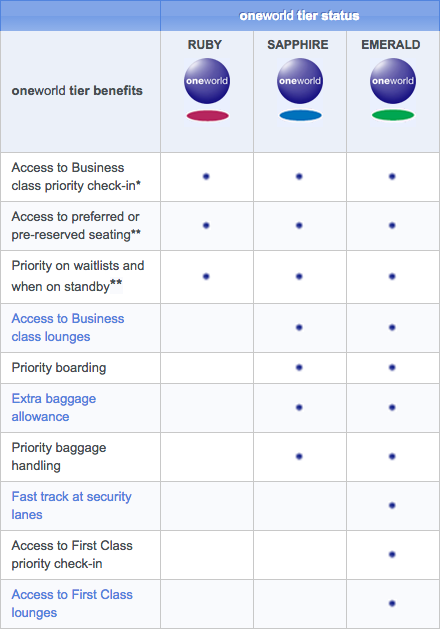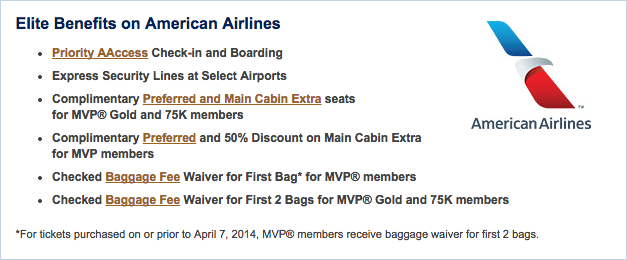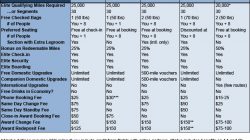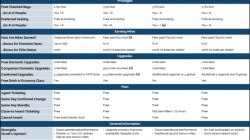Airline alliances and partnerships are some of the most complicated arrangements for the average traveler to wrap his head around. Just now, in fact, I’m trying to help my dad use his Emirates Skywards points to book an award on Alaska Airlines. “How many miles does it take?” Check with Emirates. “Is there award space?” Check with Alaska. And while searching Alaska, we also find award space for Delta and American, which are not Emirates partners.
Today’s post isn’t about booking award flights on partners — that can be a big can of worms — but often people will book a flight on a partner, whether with miles or cash, and ask if they’re entitled to any elite benefits. This is easier to answer.
In general, benefits are provided to alliance members in accordance with your alliance status. This is separate from your status with the airline.
Most airlines that are part of an alliance will confer status with that alliance when you reach their own elite tiers. For example, United Airlines, a member of the Star Alliance, will provide Star Silver if you earn Premier Silver with their MileagePlus program. Those who earn Premier Gold, Platinum, or 1K status will be provided with Star Gold.
Just how important is alliance status? It determines things like airport lounge access, free checked baggage, and priority check-in and boarding. Often “silver” alliance status only provides a free bag, but “gold” alliance status includes the more coveted lounge access. The oneworld Alliance has three tiers and goes one step further by providing access to first class lounges, where available, to its Emerald members. The other two major alliances reserve first class lounges for people actually in first class.
| Alliance Name (U.S. Member) | Bottom Tier (e.g., 25,000 miles) | Middle Tier (e.g., 50,000 miles) | Top Tier (e.g., 100,000 miles) |
|---|---|---|---|
| Star Alliance (United Airlines) | Silver | Gold | Gold |
| oneworld (American Airlines) | Ruby | Sapphire | Emerald |
| SkyTeam (Delta Air Lines) | Elite | Elite Plus | Elite Plus |
On most U.S. carriers, lounge access benefits are only recognized on international itineraries, which is why having status from another airline can be so valuable (all itineraries appear to be international). I still find it more convenient for other reasons to keep status with the airlines I actually fly.

More often than not I’ve been asked to show a valid airline loyalty card to claim these benefits since it is not as easy to look up my status from a different computer system. And, importantly, alliance status tends not to confer priority seating assignments or upgrades. I remember seeing a Lufthansa Senator storm away from the gate after being refused an upgrade on United Airlines while I, a lowly Premier Silver at the time, got a first class seat. My status with the alliance may have been lower, but I had higher status with the airline we were actually flying.
In general, benefits are not provided to partners who have a relationship outside an alliance. There may be an exception depending on the relationship.
If you are flying on a non-alliance partner — examples include Cathay Pacific and Alaska Airlines, or Etihad and American Airlines — then benefits are much more limited. These relationships tend to include only the ability to earn and redeem award miles. In some cases, but not all, they may also include the ability to earn elite qualifying miles on partner flights. Benefits of status are rarely recognized. Alaska Airlines will provide complimentary Board Room access if you travel in first or business class on an award ticket, but it can’t make its other partners provide you access to their airport lounges.
You are effectively just any ordinary passenger when you travel on a non-alliance partner. So why bother? Because of the miles. If I have a choice between flying Delta or ANA on a non-stop flight between Seattle and Tokyo, I might choose Delta because they’re a partner with Alaska Airlines, where I have a larger store of existing miles as well as elite status that lets me redeem, change, and cancel awards using those miles without paying fees. I may also earn bonus miles due to an elite status multiplier. In brief, status is still important to me, just not during the trip itself.
Sometimes there are additional benefits of non-alliance partnerships that are clearly defined for each partner. Alaska Airlines, since it is not a member of any alliance, has two well-defined partnerships with American Airlines and Delta Air Lines that include such things as free checked bags, priority boarding, reciprocal airport lounge access, and upgrades.
Update: Alaska no longer offers elite benefits on American, and it terminated its partnership with Delta. However, you can check out its benefits on other partner airlines.

One of the benefits of broad partnership networks is that they tend to play the field. In an alliance, everyone has the same friends. You don’t get to move outside that circle very far, though I will sometimes talk to different friends because sometimes they charge different prices for the same award flight. Partnerships are more flexible. Alaska has a mix of mostly SkyTeam and oneworld members among its partners. When I was primarily flying United, a member of Star Alliance, Alaska provided a convenient way of accessing the other two alliances through one account.
Partnerships can also provide a place to credit miles when you must fly on a carrier outside your preferred alliance. Going back to my dad’s problem that I mentioned at the beginning, he would be much better off had Emirates and Alaska announced their partnership a few months before his trip so he could credit the flight directly to Alaska rather than have these miles sitting in an unfamiliar program where they will soon expire.
So while partnerships may seem limited on the surface, they do have their perks. Just set your expectations accordingly.




